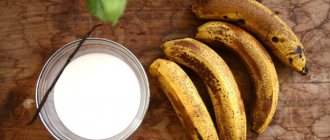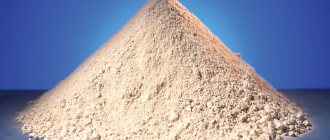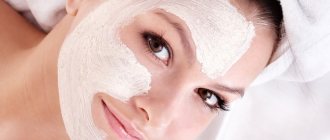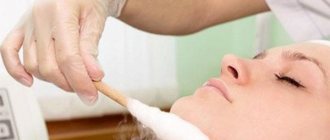Oily skin has one undeniable advantage - signs of aging appear much later on it than on dry and normal skin. However, this information does not make everyone happy, because this type of skin requires constant, careful care. Oily shine, enlarged pores, a tendency to acne - this is just an incomplete list of what you have to monitor daily. Standard daily care consisting of cleansing, toning and moisturizing the skin is not enough. The use of matting agents is also necessary.
Cosmetic clay comes to the rescue. A clay mask is an effective remedy that cleanses oily skin, dries it and mattifies it. In addition, clay tightens pores and normalizes sebum production, which significantly reduces the likelihood of acne.
Which ones are suitable?
For oily skin, yellow, green, white and blue clays are best suited because they are aimed at eliminating inflammatory processes and normalizing the functioning of the sebaceous glands. This natural remedy makes the skin clean and smooth, saturates it with nutrients, has a calming effect, eliminating redness and irritation.
The absorbent effect of a clay mask helps remove toxins from the body.
The composition of any clay includes silicon oxide and aluminum oxide. The first helps slow down skin aging. The second makes the skin smooth by exfoliating its small particles, and also dries it. The powder also contains nitrogen, iron and other useful micro- and macroelements.
Purchase recommendations:
- It is best to buy pharmaceutical clays, because... the likelihood of purchasing certified products increases.
- It is also worth paying attention to the composition of the powder. There should be nothing in it except the clay itself.
- Masks with dyes are not worth buying. Those. you do not get yellow or green clay, but white clay with the addition of a coloring agent. Such clay cannot be used, because... it may cause irritation or allergies.
- The composition may contain activated carbon or crushed herbs. This powder will not cause any harm, but the possibility of an allergic reaction to one of the additives cannot be ruled out.
- Pay attention to where the clay is mined. It should be located in environmentally friendly places.
The quality of clay depends on how well it is ground. If there are lumps, foreign impurities, the clay is of low quality.
Yellow
Yellow clay is not popular, usually few people have heard of it. But in vain, because this product is great not only for oily skin. It has a beneficial effect on aging skin. And due to its mild effect, even those with sensitive skin can use it.
The clay got its color and, accordingly, its name due to the content of potassium and iron. It also contains sodium and sulfur.
Yellow powder saturates the skin with oxygen and has a tonic effect. Clay will help if there are inflammatory processes. For example, pimples, acne, increased secretion of sebum, that is, everything that almost always accompanies oily facial skin. Due to its tonic effect, it is recommended to use it in summer.
Yellow clay reduces the visibility of fine wrinkles, improves complexion, and eliminates skin flaking.
Green
The green color is due to the content of iron oxide in the powder. The richer the shade of the powder, the more benefits it will provide.
After using it, the skin becomes velvety and soft. Green clay has a drying effect and normalizes the functioning of the sebaceous glands, which is necessary for the normal condition of oily skin. Consequently, it helps get rid of acne and other inflammations, remove oily shine.
But this type also has contraindications. Do not use the product if you have rosacea.
Clay tones, cleanses pores, removes toxins.
White
This is the most popular and widespread type of clay. Another name for it is kaolin. The color may be white, sometimes with a cream or yellowish tint.
Kaolin is an antiseptic. It helps get rid of toxins, fights viruses, bacteria and other pathogens. After using it, the skin is enriched with minerals.
This powder is indispensable for those with oily skin. It is great for problem skin and helps get rid of acne. Can be used by those with sensitive skin.
White clay is actively used in the production of cosmetics, including children's cosmetics.
Blue
Blue clay received this shade due to the presence of silver in its composition.
It is a disinfectant with anti-inflammatory properties. In addition to the general positive effect that is inherent in any clay, blue tightens pores and relieves irritation. In addition, it whitens the skin and even helps remove age spots or make them less noticeable.
Blue clay reduces skin oiliness; regular use smoothes out wrinkles.
How clay face masks help different skin types
- This component in the mask works as an absorbent. Clay pulls out all harmful substances from the epidermis - absorbs pollution, excess sebum and heavy metals. This is how detox and deep cleansing occurs. After this, the skin will be better able to accept the beneficial components of subsequent care - toner, serum or cream.
- Clay masks not only get rid of harmful substances and add beneficial ones. Korean brands add valuable components to their formulations that care for the skin and help the clay not dry out the skin so much.
- Clay normalizes the functioning of the sebaceous glands, stimulates regeneration and renewal of the skin. Tightens pores, dries and soothes inflammation.
- Clay-based masks lighten pigmentation and acne, even out tone, making the skin healthy, clean and beautiful.
Very often the question arises: why buy Korean clay face masks if you can dilute the finished product with water. The problem is that using regular clay can lead to irritation and drying - without caring components it will be too aggressive on the skin. Therefore, specialists from different brands in laboratories create unique product formulas that are truly effective and gentle on the skin. In addition, in addition to clay, masks also contain many other valuable components - for example, extracts of green tea, centella, wormwood, strawberry, and red wine.
A purifying foaming clay bubble face mask. 100 ml, 1,120 RUR
This beauty procedure is suitable for all skin types. Those with combination and oily skin will definitely like clay-based masks - they just need regular cleansing. But if you choose a clay mask for dry skin, carefully study the composition and look for pink clay and moisturizing components in it so as not to dry out the epidermis. Clay absorbs excess sebum, which dry types already lack.
Rules for preparing a mask
- When making the mixture, do not use metal utensils. It enters into a chemical reaction with the substance. Because of this, the mask becomes unsuitable for application. The spatula or spoon used to spread and apply the mask should also not be metal. It is better to use materials such as glass and ceramics.
To avoid lumps while preparing the mask, slowly pour water into the powder, and not vice versa.
- Before the procedure, you must thoroughly cleanse the skin. It is better to apply the mask to slightly damp facial skin while lying down so that the skin is not pulled down due to the weight of the mask. Do not apply the mask to the areas around the eyes, mouth and eyebrows, as... clay can dry them out. Do not use scrubs or peels before a cosmetic procedure. No need to steam your face. The mask will be effective even if it is not applied to the entire face. It is permissible to lubricate only problem areas, for example, the forehead or chin, or even individual pimples that you want to dry out quickly. This is especially true for those with combination skin.
- The mask dries the skin very much, so you should keep it on oily skin for no more than 15 minutes. Those with normal to dry skin have even less.
- During the procedure you need to relax. Do not strain your facial muscles, try not to even talk. Otherwise, the effect of the mask will decrease. And when the mixture begins to dry out on the face, any muscle movement will cause discomfort.
- Never wait until the mask is completely dry before removing it from your face. On the contrary, if you see that certain areas have dried out ahead of time, splash water on your face or apply a damp towel. Otherwise, instead of benefit, the skin will be harmed. Because when clay dries, it greatly tightens the skin.
- Remove the mask from your face after first wetting your face with water. Then gradually rinse with warm or cool water. Do not remove the mask when dry.
- When washing, you can gently massage your face, and the clay will act as a scrub. Afterwards, pat your face dry with a towel; do not rub it too hard.
- After this, be sure to use a toner, then a moisturizer to avoid the skin feeling as if it is tight.
- Cosmetologists do not give recommendations on what time of day is best to make a mask. Therefore, you can do the procedure in the morning before applying makeup or in the evening after removing it.
- To cope with oily skin imperfections, it is better to make a mask 2 times a week. Depending on the condition of the skin, some people make a mask every other day. Monitor your body's reaction when deciding how often to make masks. Noticeable changes will appear within a month. When the desired result is achieved, you can maintain it by using a mask once a week. Types of clay can be alternated.
Do not make the mask mixture several times at once, do not store it in the refrigerator or other places. Use as many ingredients as needed for one time, and prepare the mask immediately before applying it to your face.
The effect of clay on the face
Remember that the action of a clay mask consists of three stages. Have a good understanding of each of them and act accordingly.
1/ Food . A wet mask nourishes the skin with minerals, and moisturized skin actively absorbs them. At this stage, the clay absorbs excess sebum. 2/ Cooling . The still wet texture becomes cool at room temperature. This improves microcirculation, causing a glow and evening out the complexion. 3/ Drying . The clay begins to dry out, but still has a soft, elastic surface. The skin feels a slight tightening, and this is a stop signal for using the mask. It's time to wash it off or sprinkle it with water if the exposure time is not over.
Under no circumstances allow the mask to dry completely on your face. Instead of a healing effect, clay will draw precious moisture from the skin and reduce all benefits to nothing. To prevent the mask from drying out and soften the effect of the clay, you can add a few drops of oil to it.
Choose a frequency of using clay masks that is comfortable for your skin. For oily skin, these can be sessions once or twice a week, for dry skin - once every one or two weeks.
Recipes
Even if the clay is simply diluted with water and the resulting mixture is applied to the face, it will benefit oily skin.
However, it would be foolish to ignore recipes that have already been tried by owners of oily skin and which they decided to share. As a result of preparing the mask according to any of the recipes, the result should be a fairly thick mass, with a consistency similar to sour cream. Initially, it is better to adhere to the volumes or ratios of parts indicated in the recipes. However, after 3-4 times you will decide how much volume of the mask is needed to cover the entire face, and you will also understand what consistency is most convenient. After this, you can determine by eye how much to add ingredients, only adhering to the required proportions.
In masks with a large number of constituent substances, it is best to adhere to the volumes indicated in the recipe so as not to harm the skin.
Drying
Since any clay dries out the skin, in this case you can use the classic version of the mask. To do this, you need to mix clay and boiled water in proportions of 1 to 1. The result should be a lump-free mixture. Adjust the consistency yourself. Sometimes a little more water may be needed. Instead of plain water, it is permissible to use an infusion of herbs. For example, string, sage, chamomile or oak bark.
The drying mask removes excess shine while moisturizing the skin.
Follow the general rules when applying a mask. After removing, be sure to use a moisturizer.
To remove shine
For this mask it is better to use white or green clay. Mix it with water. Add glycerin. On average, 5 g of glycerin is added per 100 g of clay.
Since glycerin absorbs moisture, that is, collects it from the environment, it is better not to use a mask if the air humidity is low. For example, in winter. Otherwise, glycerin will draw moisture from the skin of the face. And although the skin is oily, it needs hydration. Find another recipe for a mask with glycerin here.
Cleansing with talc
Instead of water, mix 1 part white, green or blue clay with 2 parts warm milk. Add 1 part talcum powder.
This mask will not only cleanse the skin, but also dry it.
Cleansing and tightening pores
For 1 tsp. white clay use a quarter tsp. carbonated magnesium, the same amount of borax and half a tsp. talc. Instead of water, fill the mixture with 3% hydrogen peroxide.
Apply the resulting paste to your face for 15 minutes, then rinse off.
For cleansing and mattifying
To prepare the mask, you need to mix 1.5 tbsp. white clay, the same amount of starch, 5 tbsp. magnesium carbonate, 1 tbsp. l. talc. Then add half a teaspoon each of boric acid powder and alum. Fill everything with 3% hydrogen peroxide until the desired consistency is formed.
Monitor the quantity yourself. If it turns out too much, reduce the volume of components used, maintaining the proportions. The most effective starch masks are here.
You cannot store the mask until next time, so you should carefully select the proportions.
For whitening with kaolin
For a whitening effect, use white or blue clay. Take 2 tbsp, add 1 tsp to them. liquid honey, 1 egg white and 2 drops of lemon juice. Pour in all 3 tbsp. boiled water. Stir until no lumps remain. Apply to face. Also read about other masks with lemon in the article.
For acne and inflammation with aloe
Mix the 3 main ingredients of the mask in the following proportions: 2 parts clay, 1 part water and 1 part juice. Apply the resulting aloe mask to your face, then rinse and use a moisturizer.
This mask regulates the functioning of the sebaceous glands, narrowing the pores.
Tonic with cucumber juice
It is advisable to use fresh cucumber juice. Therefore, it is most convenient to prepare a mask in the summer, when you have access to fresh vegetables.
To obtain a cosmetic mixture, add 1 part white clay and 1 part blue clay to 3 parts cucumber juice. Apply the mask and then rinse, following the general recommendations. The best cucumber masks are collected in this material.
Nourishing with kefir
Use 2 parts white or green clay. Dilute it with 2 parts water and 1 part kefir. Add a couple drops of lemon juice. If you make a mask in the summer, add a teaspoon of finely chopped parsley. The mask will become even more useful.
Apply and rinse as usual. Other kefir masks are presented at the link.
Whitening with moisturizing effect
If possible, you can use a rather exotic recipe that requires adding papaya pulp to the mask.
To prepare, mix 2 tbsp. l. pulp with 2 tsp. clay of any color, add 1 tsp. aloe juice Apply the finished mixture to your face and rinse after 15 minutes.
Whitening masks cope well with problematic skin pigmentation.
Rules for using masks to narrow pores
Homemade mixtures have not undergone clinical studies. Some remedies help some quickly, while others have a weak effect. The same ingredients have different effects on oily and combination skin.
Natural ingredients rarely cause unwanted symptoms, but only if the masks are used correctly.
- Before the procedures, the dermis is cleaned of cosmetics, preferably with plain water and soap. For oily skin types, soap is selected with a pH close to natural – 5.5.
- The compositions are applied systematically over several weeks. During the course you need to give up fatty creams, and in the summer, foundation.
- Some types of mixtures can be stored for several hours in the refrigerator, but it is better to use freshly prepared mixtures.
- Seasonal products are used to make compositions from vegetables and fruits. Ripe fruits are maximally enriched with nutrients and do not contain chemicals that cause side effects.
- Mixtures containing acid are applied for no more than half an hour. If the epidermis is highly sensitive, use a moisturizer after the procedure.
- Procedures should not be abused. Most products have a drying effect. Frequent use may cause irritation.
Homemade creams may be ineffective if you do not adhere to a healthy diet or abuse cosmetics.
Recommendations for use
As previously mentioned, clay does not cause allergies, so it can be used by everyone. But the masks contain various components. It may turn out that you are allergic to one of them. Therefore, carefully consider the composition of the mask before applying it to your own face. Make sure that you do not have an individual intolerance to any component of the recipe.
To do this, check the composition in the standard way. Apply the components to a small area of the elbow in advance. Leave on for half an hour, then rinse off. If no reaction is detected after a day, the mask can be used.
Remember that although masks with clay are effective, you should not limit yourself to them. Watch your diet and choose the right skincare products to reduce the appearance of oily shine and get rid of rashes.
Blue
The blue color comes from silver molecules, which act as an anti-inflammatory and disinfectant. In part, it took over the properties of white clay, as well as blue, which stimulates cell regeneration.
The composition includes cadmium, cobalt, including in the form of salts, silicon, magnesium, iron, and other minerals.
Cleansing mask
The product first opens and then cleanses pores and gets rid of oily shine. First, grind the rice into powder using a coffee grinder. Then take clay and rice powder in equal parts, add water, and dilute it to the consistency of sour cream. The mixture is left for a quarter of an hour and removed with warm water.
conclusions
- Clay masks at home are an effective remedy for combating imperfections in oily skin.
- For oily skin, white, yellow, green and blue clays are best suited.
- This cosmetic product does not cause allergies, so anyone can use it.
- However, before using the mask, make sure that you are not allergic to its other components.
- Never prepare a mask mixture in a metal container.
- Do not let the clay dry on the skin, otherwise you will get the opposite effect from using it.
- In addition to using cosmetic clay, do not forget to monitor the condition of your skin in other ways: eat right, choose high-quality cosmetics.
What could make the problem worse?
Enlarged pores on the nose - what can be done in this case? It is very difficult to solve the problem with enlarged pores once and for all. But it’s worth thinking about the factors that create the problem and removing them. According to experts, the following habits negatively affect facial skin and make life difficult for pores:
- great love for the sun, prolonged exposure to the rays of the sun;
- loss of water in the skin, insufficient amount;
- bad habits;
- eating fast food in large quantities;
- the skin is not cleaned properly and thoroughly;
- The wrong products are selected for home care. This also applies to the use of decorative cosmetics; they must also be suitable for your skin type and be of good quality.











